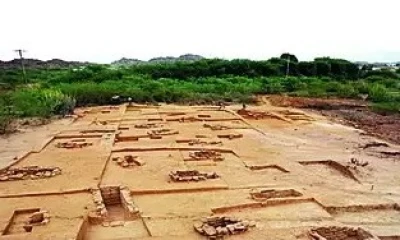In a groundbreaking discovery, an extensive necropolis containing over 500 graves, initially uncovered in 2018 in Gujarat’s Kutch region, has unveiled a remarkable connection to a Harappan-era settlement dating back over 5,000 years. Led by Dr Subhash Bhandari, head of the archaeology department at Krantiguru Shyamji Krishna Verma Kachchh University, the excavation has shed light on a previously unknown facet of ancient civilization.
Dr Bhandari explained that the excavation near Juna Khatiya village prompted few important questions like “it was necessary to find out where these people stayed. This was a major question and we were looking for the answer”.
This pursuit ultimately led the archaeologists to Padta Bet, situated approximately 1.5 km from the burial site. Here, on a hillock measuring about 200 m x 200 m, they uncovered the remains of a settlement believed to have been inhabited during the Harappan period.
Dr Bhandari further elucidated about the discovery of numerous structures, including round and rectangular dwellings, artifacts such as pottery and dishes, semi-precious stones like carnelian and agate, as well as shell fragments and hammer stones at Padta Bet. It was found that the settlement was in close proximity to a former riverbed.
“Based on our analysis, we estimate this settlement site to be approximately 5,700 years old,” he stated, indicating a substantial timeline spanning from the early Harappan to the late Harappan era.
Moreover, the excavation unearthed remnants of domesticated animals, including cows and goats, suggesting a reliance on animal husbandry among the inhabitants. “This indicates the agrarian lifestyle and economic activities of the ancient settlers,” Dr Bhandari remarked. Additionally, the team uncovered the remains of a human skeleton, providing further insights into the demographic composition and perhaps burial practices of the ancient community.
University of Kerala assistant professor and project co-director Rajesh SV stated, “The presence of the hillock at Padta Bet raises intriguing possibilities regarding its relationship with the skeletal remains discovered at Juna Khatiya’s burial ground. Our current findings indicate that Padta Bet could have been among several settlements connected to the burial site at Juna Khatiya.”
University of Kerala’s Archaeology Department Head and excavation leader Professor Abhayan GS proposed two plausible explanations as researchers have identified two localities with archaeological deposits at Padta Bet.
He suggested that population growth might have prompted the expansion of settlements from one locality to another. Alternatively, the two localities might have been inhabited during different chronological periods.
On structure’s scarcity at the settlement site, Professor Abhayan elucidated, “The topography of this site, situated on a hillock, renders the landscape inherently unstable. This instability could have contributed to the gradual collapse of many structures over time.”
Besides, he explained talked about the strategic importance of the Padta Bet location that “the site offers commanding views of the surrounding mountains and valleys and the nearby river possibly served as a vital water source for the inhabitants of this area”.
Dr Bhandari explained their focus is on unearthing more about the burial site and the settlement connection and the people who lived there. Located on a hillock, the people on the site got a clear view of the surroundings.
“We will try to find out whether that was from a strategic point of view or due to the availability of water nearby. We will also try to find out their food habits. We have found stones, so we will explore if their occupation was largely pastoral or they were also into trade,” he said.
The collaborative effort involves several esteemed institutions, including the University of Kerala, Kachchh University, Deccan College in Pune, the Central University of Karnataka, as well as three Spanish institutes – Catalan Institute of Classical Archaeology, Spanish National Research Council, and University of La Laguna. Additionally, Albion College and Texas A&M University in the United States are contributing to this interdisciplinary project.

















